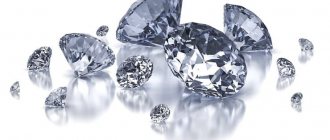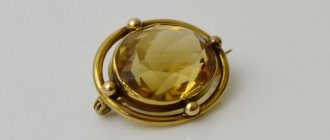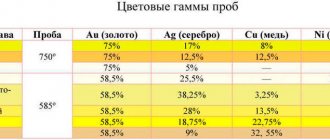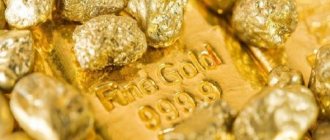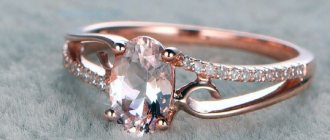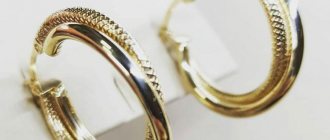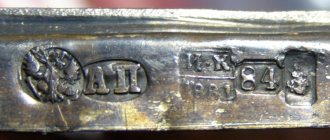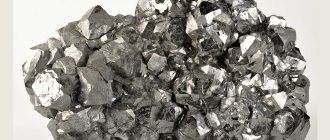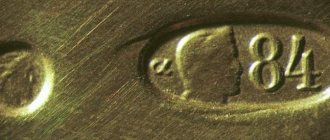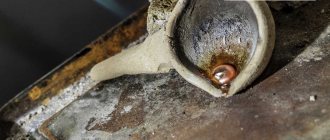Post updated: May 28, 2020
If you ask what colors gold comes in, many will answer: white or yellow, because the ratio of 585 yellow gold in jewelry is the highest.
Some will remember seeing a gold bracelet in red, pink and green shades. The most unexpected thing will be to find out that jewelry made of black gold is and is available! When choosing gold, you should remember that the higher its purity, the softer the metal becomes. However, it is worth noting that, as a rule, white gold is stronger than yellow gold.
Modern technologies make it possible to “paint” gold in the most unexpected colors.
White and yellow gold
Any gold from jewelry products is an alloy of metals. Fineness is the amount of gold, silver, platinum or palladium in a master alloy, which is a derivative for the manufacture of jewelry. In Russia, jewelry is assigned the following hallmarks: 375, 500, 583, 585, 750 and 958. 585 yellow gold is an alloy with other components in proportions of 585 to 415.
Thus, if you take one kilogram of 585-carat gold, it will contain 585 grams of pure gold, and the rest is alloy (admixture of other metals). The content of 58.5% gold in the product is 585th purity, 75% is 750th purity. The higher the percentage of gold contained in the alloy, the higher its purity and price will be. The purest gold is considered to be pure gold, containing 90 percent of gold itself; it has 900 or higher purity.
Gold color chart.
But at the same time, the sample does not answer the question of how “jewelry” of the same sample can have different colors. So, 585 gold can be red, but it can also be 750 gold. The color of jewelry gold can range from red to green, depending on the impurities it contains. Zinc, silver and palladium give gold a white and yellow-green tint, and copper can “paint” the metal orange and red.
Price per gram of gold
The cost of 585 and 583 gold samples is almost the same. In institutions that purchase metal, the price is slightly lower and differs within 5%. When delivered to a pawnshop, the product is assessed as scrap. The artistic value and skill of jewelry craftsmen are not taken into account.
The price of gold in institutions that issue loans secured by gold products is significantly lower than the cost of 1 g of gold in Sberbank.
Regarding the retail price for 1 g of gold in a piece of jewelry, the main factor influencing its formation is the artistic value and brand of the jewelry house.
You can invest in jewelry, but the end goal of making a profit does not always allow you to get the desired result. It is difficult to sell gold in jewelry unless it is of antique value.
Yellow gold
It has a very real and familiar color - bright, sunny, yellowish, to put it simply - gold as it is and as we are used to. Actually, it is for this that gold has been valued since ancient times, and has also earned a reputation as a jewel, a symbol of wealth and power. In Western countries, golden yellow is often used in wedding rings. There is a popular belief that yellow gold is a symbol of warmth and love between spouses. Yellow gold is mostly 750 fine. Much less often it is presented in 585 yellow gold.
You can turn yellow gold into white by putting the jewelry in rhodium, this technology is called rhodium plating.
You can see the 585 yellow gold in the photo below:
Yellow gold is the classic and most common color option for jewelry.
Color palette
The natural color of gold is bright, sunny yellow, but various alloys can make their own adjustments and give the alloys amazing shades. Jewelers use this property to create original products and do not refuse the opportunity to add less valuable metals with desirable qualities to noble metals.
Bright colors up to red are provided by the presence of copper. The silver additive, depending on the percentage, will give rise to a greenish tint at low doses or white-yellow if the argentum is about a third of the mass of the alloy. Chromium and cadmium alloy will color the alloy black. Such a product must be coated with a rhodium layer.
The use of noble platinum helps create the so-called white gold. The aristocratic and elegant trend has remained at the peak of popularity among jewelry lovers for several years now. But since the resulting alloy is very expensive, the jewelry industry often uses cheaper alloys :
- The white tint of a gold alloy appears when it contains at least 10% palladium.
- A greenish color may indicate the presence of zinc additives.
- A pale yellow color can be achieved by adding nickel to the composition, but it is worth considering that this metal can cause magnetic and allergenic properties. Undesirable features of the influence of ligatures on humans are neutralized by a special coating of the product, which will have to be renewed.
Domestic traditions and modernity
In Russia, red gold has always been valued - the purest. Today, products made from a material with the same name can be either 18 carats (750 standard) or 22 carats.
Traditionally, copper is used . Thanks to its presence, red tones appear, the intensity of which depends on the percentage of this particular additive.
However, the 583 sample has become most widespread since Soviet times, and only in 1994 the transition to the international standard was made - 585 sample. This means that the alloy now contains 58.5% precious metal, 0.2% more.
Black gold
In order for the alloy to acquire a black color, the following technological methods are performed.
The top layer of the product is coated with black rhodium or ruthenium is electroplated; the color can range from gray to black.
The surface of a gold item is covered with a layer of amorphous carbon. Most often, this technology is used for the manufacture of gold watch cases.
Another way to obtain the black color of gold is an alloy containing cobalt in a ratio of 10 percent and 15% chromium, with an oxidation procedure at a temperature of 700-900 degrees Celsius.
Where is 585 standard yellow metal used?
Most often the precious metal is used:
- In the jewelry industry;
- In electronics;
- In the creation of religious objects and church accessories;
- In the chemical industry;
- As a means of preserving capital;
The most widespread use of this material is, of course, in jewelry production. Then comes the creation of church utensils, decorating domes, covering decorative elements, and similar purposes. Precious gold also has unique physical properties: it conducts current very well, is very resistant to chemicals, and is practically not subject to corrosion. This led to the widespread use of metal in the production of electronics and printed circuit boards, in the creation of special chemical glassware, and, of course, as a means of preserving accumulated values.
White gold
Gold alloys have a white color due to the addition of palladium, acquiring increased brightness and shine. Nowadays, white gold is a fashionable material, often used in the fashion industry among jewelry aficionados. Products made of white gold have a prestigious status and reflect the belonging of its owner to the highest class. Outwardly, it is as similar as possible to platinum, but costs almost half as much.
White gold ring.
Alloys and their features in different countries
Different countries formed their own jewelry traditions; different metals were included in the ligature, which is why the density and specific gravity of the alloys were different.
Even externally the products differed in color:
- Arab craftsmen make jewelry from raw materials of at least 750 standard. Due to the low content of added metals and high gold content, the products have a characteristic yellow color.
- In Italy, jewelers use gold alloys containing silver for their work. Thanks to this metal, a very specific cold shade of yellow is achieved, which connoisseurs and connoisseurs consider aristocratic and noble.
- For Europeans and Americans, yellow gold is traditional. This is what wedding rings are usually made from. Moreover, in America, many products have only 9 carats, which corresponds to 375 fineness.
A little about investments
You can often hear the statement that when buying jewelry, a person is making a profitable investment, because gold practically does not depreciate. This is not entirely true. Indeed, antique unique items by famous masters can be very expensive, and auctions confirm this: collectors are willing to pay a lot of money for antiques.
However, they are not interested in ordinary “jewelry,” and in a pawnshop they will not offer the amount for which they were purchased for a beautiful ring or brooch that belonged to their mother. Moreover, they will only value gold, and even then as scrap. But considering that there are not so many antiques, what option remains?
Experienced experts advise: if you really want to invest money in precious metals, it is better to buy bank gold bars of 999 purity.
They are soft and require special storage conditions. Aurum in them is almost perfectly pure, its content is 99.9%. This is the highest grade in the metric system, but is rarely used for jewelry.
How to determine authenticity
You can independently determine the authenticity of the purchased product in several ways:
- Scratch the alloy onto unglazed porcelain. If the stripe is dark and not golden, it means pyrite is in the hands of the owner.
- Pass the product along the glass. The absence of any trace will confirm the authenticity of the metal.
- Apply a drop of iodine solution to the surface and wipe off with a napkin after five minutes. Darkening of the color will indicate authenticity. Treatment of other metals with iodine does not change the color shade.
A radically simple way to check for the presence of large amounts of metal impurities is exposure to a magnet. When brought to it, a high-grade alloy should be attracted very weakly. A more noticeable attraction indicates the presence of magnetic metal. In the absence of a magnet, acetic acid can successfully replace it. The metal that darkens in it is not gold.
It must be remembered that the above methods only help to determine, as a first approximation, how high the authenticity is. It is not possible to find out his sample in this way. This requires a detailed chemical analysis of the alloy in the laboratory. It can be carried out either using electronic scanners or “the old fashioned way” - using fluoroscopy. The most accurate way to determine what exactly 585 purity is in your hands, and what purity this gold is, is assay analysis. But it is used extremely rarely, since the sample being tested must be strongly heated and combined with other metal agents (silver and lead). Finally, this method is very expensive, so it is used mainly in industrial production.
Physical and chemical properties
In chemistry, yellow gold (aurum) is a soft, ductile and very heavy metal with high thermal conductivity and low electrical resistance. One of its main features is the electronic structure of the atom, due to which the element absorbs photons in the short-wavelength part of the visible spectrum, and reflects long-wavelength quanta with lower energy. This is why gold appears yellow when illuminated with white light.
What makes this metal noble is the fact that under normal conditions it is chemically inert to most acids. An exception is aqua regia, which consists of concentrated aqueous solutions of nitric and hydrochloric acids in a ratio of 1:3. In addition, the reaction can occur with mercury and cyanide.
Where to buy and sell
The safest way to buy gold is through a jewelry store. All finished products have certification and their own passport. But you can buy jewelry without documents in many places:
- in the Internet;
- in a pawnshop;
- in private advertisements;
- On the market.
In all these cases, there is no guarantee of the originality of the product, and it is quite possible that it has a hidden defect that will only be revealed in a couple of days. But you can get good jewelry by paying much less for it than in a jewelry store.
How much does 1 gram of gold of this standard cost today?
The Central Bank of the Russian Federation changes the gold rate in the same way as currency rates. And the final cost of jewelry depends on this. Let's look at today's prices:
Advantages and disadvantages
Advantages:
- High durability for the jewelry world;
- Relatively low price for high sample media;
- The degree of density allows you to make different patterns;
- Changing the composition of impurities allows you to play with shades.
The 585 stamp also has quite a few disadvantages. Due to the high alloy content. Scratches may appear on their surface, and this is typical for all gold jewelry.
How many carats are in a sample?
The alloy rating system in Russia is metric, i.e. the number written in the frame indicates the proportion of gold in the product. Europe and America use a multiple system for this. The purest precious metal has a value of 24. This means that the jewelry contains 14 parts of gold and 10 parts of impurities. In terms of numerical correspondence, this is equal to approximately 585 samples. Compliance table:

